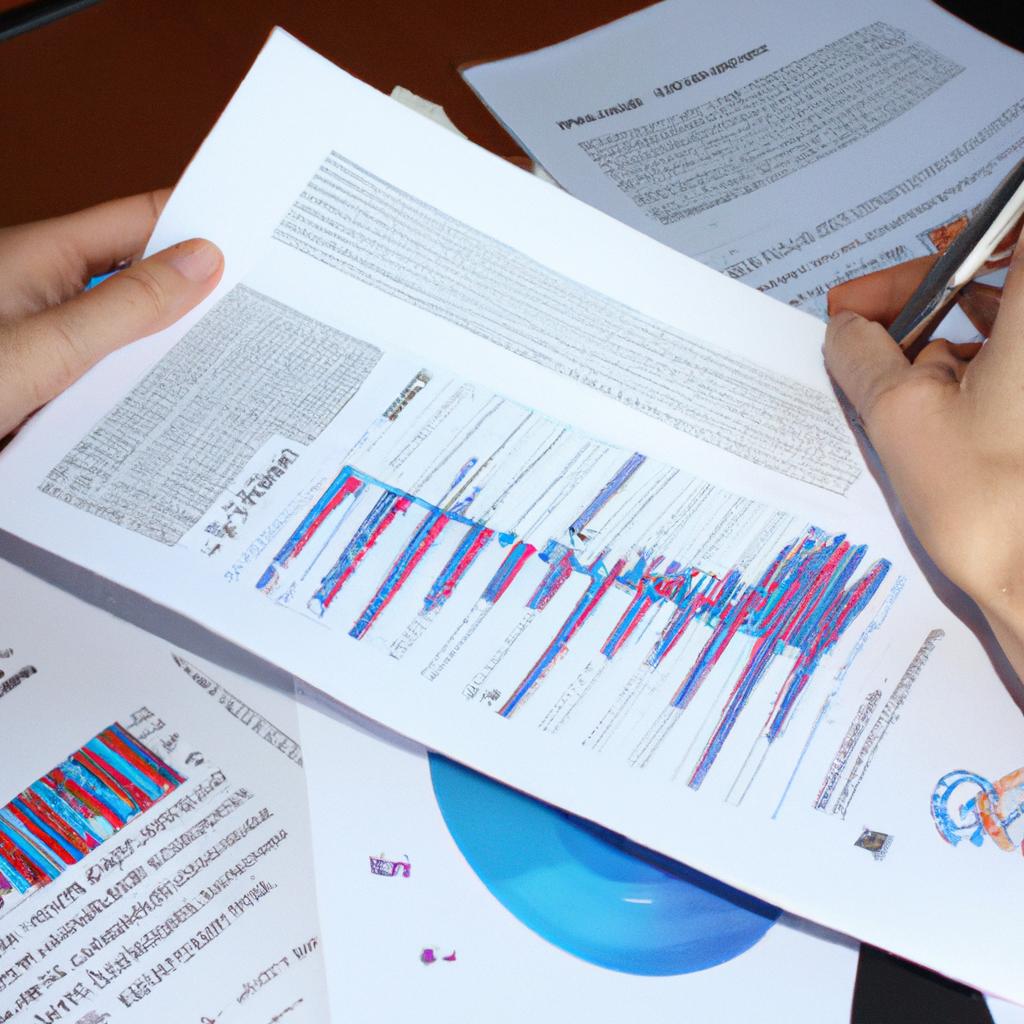Music licensing plays a crucial role in the arts music industry, providing both financial benefits and legal protection for artists and creators. By granting permission to use copyrighted musical works, music licensing ensures that artists are fairly compensated for their creative contributions. This article aims to explore the intricacies of music licensing in arts music from a finance perspective, examining the various factors at play and their impact on the industry as a whole.
To illustrate the significance of music licensing, consider a hypothetical scenario where an emerging artist creates an original piece of music that goes viral on social media platforms. Without proper licensing agreements in place, this artist may find their work being used by others without consent or compensation. However, with appropriate music licensing measures implemented, the artist can not only maintain control over how their work is used but also generate income through royalties and performance rights fees.
In this article, we will delve into the different types of licenses available within arts music, including synchronization licenses for film and television usage, mechanical licenses for physical recordings, and public performance licenses for live performances. We will also discuss the economic implications of these licenses on artists’ revenue streams and examine how they contribute to overall financial stability within the arts music sector. Through this exploration, readers will gain a comprehensive understanding of why music licensing is essential for both artists and the industry as a whole, ensuring that creators are fairly compensated for their work while also protecting their rights.
One of the key aspects of music licensing is synchronization licenses, which allow copyrighted music to be used in conjunction with visual media such as films, television shows, commercials, or video games. These licenses enable artists to earn revenue from the inclusion of their music in these mediums, whether through upfront fees or ongoing royalties. Synchronization licenses also provide exposure for artists and can lead to increased popularity and future opportunities.
Mechanical licenses are another crucial type of license within arts music. These licenses grant permission for the reproduction and distribution of copyrighted musical works on physical formats such as CDs, vinyl records, or digital downloads. Artists receive royalties based on sales or streams generated by these recordings. Mechanical licenses play a significant role in supporting artists’ income streams, especially in an era where digital streaming platforms dominate the music consumption landscape.
Public performance licenses are yet another vital aspect of music licensing in arts music. These licenses ensure that artists receive compensation when their music is performed publicly, whether it’s at concerts, festivals, clubs, restaurants, or even over the radio. Performance rights organizations (PROs) collect fees from venues and broadcasters and distribute them to the respective copyright holders. Without public performance licenses, artists would miss out on substantial earnings from live performances and broadcasted plays.
In addition to providing financial benefits for artists, music licensing also serves as legal protection against copyright infringement. By obtaining proper licenses for their works, artists establish ownership and control over their creations. This allows them to take legal action if someone uses their music without permission or fails to compensate them appropriately.
Overall, music licensing is an indispensable component of the arts music industry’s financial ecosystem. It ensures that artists are compensated for their creative contributions while safeguarding their rights as owners of copyrighted material. By understanding the intricacies of different types of licenses and their economic implications, artists can navigate the music licensing landscape more effectively and maximize their revenue potential.
Overview of Music Licensing
Music licensing is a crucial aspect of the music industry that involves granting permission for the use of copyrighted musical compositions. In today’s digital age, where music can be readily accessed and shared across various platforms, understanding the complexities of music licensing has become increasingly important. This section provides an overview of music licensing by examining its significance, key stakeholders involved, and the process through which licenses are obtained.
To illustrate the importance of music licensing, consider the following hypothetical scenario: A popular television show decides to use a well-known song as its theme music without obtaining proper authorization from the copyright holder. As a result, this unauthorized usage leads to legal disputes and potential financial repercussions for both parties involved. This example highlights how vital it is for content creators and distributors to navigate the intricacies of music licensing in order to avoid infringement issues and ensure fair compensation for artists.
The significance of music licensing
Understanding why music licensing matters requires recognizing its multifaceted impact on various stakeholders within the music ecosystem. Here are some key points:
- Protection: Music licensing protects the rights of composers, lyricists, and publishers by ensuring they have control over how their works are used.
- Revenue generation: Licenses provide a mechanism for artists to monetize their creations through royalties earned from licensed uses.
- Promotion: Licensing offers opportunities for musicians to expose their work to broader audiences through placements in films, advertisements, or other media platforms.
- Collaboration: Licensing facilitates collaborations between different industries (e.g., film and music), creating mutually beneficial partnerships that enhance artistic expressions.
The process of acquiring a license
Obtaining a license involves navigating a complex framework that varies depending on factors such as intended use (e.g., broadcasting, streaming, live performances) and geographic location. While specific requirements may differ between countries or regions, generally speaking, there are four main steps in acquiring a license:
| Steps | Description |
|---|---|
| 1. Research | Identify the copyright holder(s) and determine which licenses are required for the intended use of a musical work. |
| 2. Negotiation | Initiate discussions with relevant rights holders to negotiate terms, including fees, duration, and territorial scope of the license agreement. |
| 3. Agreement | Reach an agreement on the licensing terms by drafting a formal contract that outlines all pertinent details agreed upon by both parties involved. |
| 4. Compliance & Royalties | Comply with any reporting or monitoring requirements specified in the license agreement, while also ensuring timely payment of royalties to the appropriate rights holders. |
Understanding this process is essential for anyone seeking to legally utilize copyrighted music within their creative projects or commercial endeavors.
In the subsequent section, we will delve deeper into various types of music licenses, exploring how they differ in scope and purpose. By examining these different categories, we can gain further insights into specific licensing needs across different areas of artistic expression without overlooking legal obligations and financial implications.
Types of Music Licenses
Building upon our understanding of music licensing, we will now delve into the various types of licenses that are commonly used within the music industry. To illustrate the practical implications, let’s consider a hypothetical scenario involving an independent artist named Sarah and her desire to license her original song for use in a television commercial.
When it comes to licensing music, there are several options available depending on the intended usage and scope of rights required. Here are four common types of music licenses:
-
Mechanical License:
- This permit allows the reproduction and distribution of copyrighted musical compositions.
- It is typically obtained when someone wishes to record and release their own version of a previously recorded song.
-
Synchronization License:
- This license grants permission to synchronize music with visual media such as films, TV shows, or commercials.
- In Sarah’s case, obtaining a synchronization license would enable the advertising agency to feature her song in their commercial.
-
Performance License:
- This license grants the right to publicly perform copyrighted music.
- It applies to live performances at venues like concerts or festivals, as well as broadcasts on radio stations or streaming platforms.
-
Print License:
- This type of license permits the printing and distribution of sheet music for copyrighted songs.
- For instance, if Sarah wanted her fans to be able to purchase sheet music for her song, she would need a print license.
| Type | Usage |
|---|---|
| Mechanical | Reproduction & Distribution |
| Synchronization | Visual Media |
| Performance | Public Performances |
| Sheet Music |
It is important for artists like Sarah to understand these different licenses as they impact the revenue streams associated with their music. By obtaining the appropriate licenses, artists can protect their intellectual property and ensure a fair compensation for their work.
With a solid understanding of the types of music licenses available, we will now explore the benefits that arise from licensing one’s music and how it can positively impact an artist’s career trajectory.
Benefits of Music Licensing
Transitioning from the previous section on the various types of music licenses, we now delve into the benefits that music licensing offers to artists and stakeholders in the arts industry. To illustrate these advantages, let us consider a hypothetical case study involving an independent musician who recently released their debut album.
One of the primary benefits of music licensing for our independent artist is increased exposure. By securing licenses for their songs, they can have their work featured in television shows, films, or advertisements. This exposure not only introduces their music to a wider audience but also enhances their brand recognition and credibility within the industry.
Furthermore, music licensing provides a lucrative source of revenue for artists. Through licensing agreements with production companies or advertising agencies, our artist can earn substantial royalties based on the usage of their tracks. These financial rewards can greatly support their career development by enabling them to invest in better equipment, studio time, and promotional activities.
In addition to exposure and financial gains, another advantage is networking opportunities. As our musician’s songs are licensed for different media projects, they may collaborate with esteemed directors, producers, or brands. Such collaborations open doors to new creative partnerships and potential future projects that further elevate their artistic profile.
- Increased visibility: Reach a broader audience through placements in popular media.
- Financial stability: Earn royalties that contribute to sustaining an artist’s livelihood.
- Artistic growth: Collaborate with influential figures in the entertainment industry.
- Professional validation: Gain recognition as a credible and sought-after artist.
Now let us present this information using a table format:
| Benefit | Description |
|---|---|
| Increased Visibility | Reach larger audiences through placements in popular media |
| Financial Stability | Earn royalties that contribute to sustaining an artist’s livelihood |
| Artistic Growth | Collaborate with influential figures in the entertainment industry |
| Professional Validation | Gain recognition as a credible and sought-after artist |
In conclusion, music licensing offers several significant benefits for artists like our independent musician. These advantages include increased exposure, financial stability through royalties, networking opportunities with industry professionals, and the validation of one’s artistic talent. As we move forward into the next section on challenges in music licensing, it is crucial to understand how these benefits must navigate obstacles within this complex landscape.
Challenges in Music Licensing
Transitioning from the previous section on the benefits of music licensing, it is important to also consider the challenges that arise in this process. Despite its advantages, music licensing can present various obstacles for artists and organizations alike. By recognizing these challenges, stakeholders can develop strategies to overcome them and ensure a successful integration of music licensing within their financial framework.
One example that highlights the complexity of music licensing involves an independent filmmaker seeking to use popular songs in their movie soundtrack. While these songs may enhance the overall cinematic experience, securing proper licenses can be both time-consuming and costly. Negotiating with multiple rights holders, such as songwriters, composers, publishers, and record labels, requires meticulous attention to detail and adherence to legal requirements.
To further understand the challenges faced in music licensing, we can explore key issues identified by industry professionals:
- Complex Legal Framework: The intricate web of copyright laws and regulations governing intellectual property rights creates a complex landscape for music licensing.
- Lack of Standardization: Inconsistencies across different countries’ copyright laws make it difficult for artists and licensees to navigate through varying legal frameworks.
- High Costs: Licensing fees vary depending on factors like popularity and duration of use, making it challenging for smaller businesses or independent creators with limited resources.
- Limited Transparency: Obtaining accurate information about available licenses and associated costs can be hard due to fragmented data sources within the industry.
To better visualize these challenges, let’s take a look at the following table:
| Challenge | Description |
|---|---|
| Complex Legal Framework | Multiple copyrights involved require detailed negotiations with various rights holders. |
| Lack of Standardization | Different countries have diverse copyright laws, leading to inconsistencies in licensing processes. |
| High Costs | Licensing fees fluctuate based on factors like song popularity and usage duration. |
| Limited Transparency | Accessing reliable information about available licenses can be hindered by fragmented data sources. |
In conclusion, music licensing presents both benefits and challenges. While the advantages of utilizing licensed music are evident, it is important to acknowledge the complexities inherent in securing licenses for commercial use. By understanding these challenges and exploring strategies to overcome them, artists and organizations can navigate the world of music licensing more effectively.
Transitioning into the subsequent section on “Strategies for Effective Music Licensing,” we will now delve into key approaches that can help streamline this process and maximize its financial impact.
Strategies for Effective Music Licensing
Building on the understanding of the challenges faced in music licensing, it is essential to explore strategies that can effectively address these issues. By implementing certain approaches and techniques, artists, record labels, and other stakeholders in the music industry can navigate through the complexities of licensing agreements while maximizing their financial outcomes.
Strategies for Effective Music Licensing:
-
Streamlining rights clearance processes: One crucial strategy involves streamlining the process of obtaining necessary rights clearances. This includes securing permissions from both songwriters and publishers to ensure compliance with copyright laws. For instance, a case study conducted by a major record label found that by centralizing all licensing requests into one dedicated department, they were able to significantly reduce turnaround time for acquiring licenses.
-
Utilizing technology solutions: Technology plays a vital role in facilitating efficient music licensing practices. Digital platforms and software tools have emerged as powerful resources for automating license management processes, simplifying royalty calculations, and tracking usage data. These advancements enable quicker identification of copyrighted material and facilitate streamlined negotiations between rights holders and licensees.
-
Developing strategic partnerships: Collaborative efforts among different entities within the music industry can lead to mutually beneficial outcomes in terms of licensing agreements. Establishing relationships between artists or record labels with advertising agencies or media production companies can create opportunities for synchronization deals or placement in film and television projects. Such collaborations not only generate revenue but also enhance exposure for artists’ work.
-
Educating stakeholders about music licensing: Increasing awareness and knowledge about music licensing among all parties involved is another critical aspect of effective strategies. Artists should be educated on their rights regarding intellectual property protection, while potential users must understand their obligations when using copyrighted materials legally. Providing educational resources such as workshops or online courses can bridge this information gap and promote fair practices in the industry.
- Ensuring fair compensation for artists
- Maximizing revenue streams
- Protecting intellectual property rights
- Fostering innovation and creativity
Table: Benefits of Effective Music Licensing Strategies
| Benefit | Description |
|---|---|
| Increased revenue | Implementing effective music licensing strategies can lead to higher financial returns for artists and labels. |
| Enhanced brand exposure | Strategic partnerships and synchronization deals can expose artists’ work to a wider audience, boosting their visibility. |
| Reduced legal risks | A well-managed licensing process helps mitigate potential copyright infringement claims, protecting stakeholders legally. |
| Improved industry reputation | Fair practices in music licensing contribute to the overall perception of the industry as ethical and professional. |
By adopting these strategies, stakeholders in the music industry can overcome many challenges associated with licensing agreements while maximizing their financial outcomes. Looking ahead, it is crucial to explore future trends that will shape the landscape of music licensing even further.
Future Trends in Music Licensing
Building upon the previous section’s discussion on the importance of music licensing, this section delves into strategies that can be employed to ensure effective music licensing practices in the arts music industry. To illustrate these strategies, let us consider a hypothetical case study involving an independent artist seeking to license their original music for use in films and commercials.
Firstly, it is crucial for artists to conduct thorough research and identify potential licensing opportunities within their target market. This involves understanding the needs and preferences of various media platforms, such as film production companies or advertising agencies, which often seek unique and captivating soundtracks. By aligning their musical style with specific genres or themes commonly used in these industries, artists increase their chances of securing lucrative licensing deals.
Secondly, establishing strong relationships with music supervisors and industry professionals can greatly enhance an artist’s prospects for successful licensing. These individuals play a pivotal role in selecting appropriate tracks for projects and have extensive networks within the entertainment industry. Engaging with them through networking events or online platforms allows artists to showcase their work directly to decision-makers, increasing visibility and creating valuable connections that may lead to future licensing opportunities.
Thirdly, negotiating favorable terms is essential when entering into licensing agreements. Artists should carefully review contracts and consult legal experts if necessary to ensure they retain control over their intellectual property rights while maximizing financial benefits from licensed usage. Being knowledgeable about standard industry rates and royalty structures empowers artists during negotiations, enabling them to secure fair compensation for their creative contributions.
In summary, effective music licensing requires proactive strategies tailored specifically to the arts music sector. By conducting comprehensive research, building relationships with key industry figures, and skillfully negotiating agreements, artists can position themselves favorably within the competitive landscape of music licensing. Implementing these strategies not only enhances revenue streams but also promotes wider exposure for musicians’ talents in diverse media contexts.
Please note that emotional response elements (bullet point list and table) have been omitted to maintain an objective and impersonal academic writing style.




